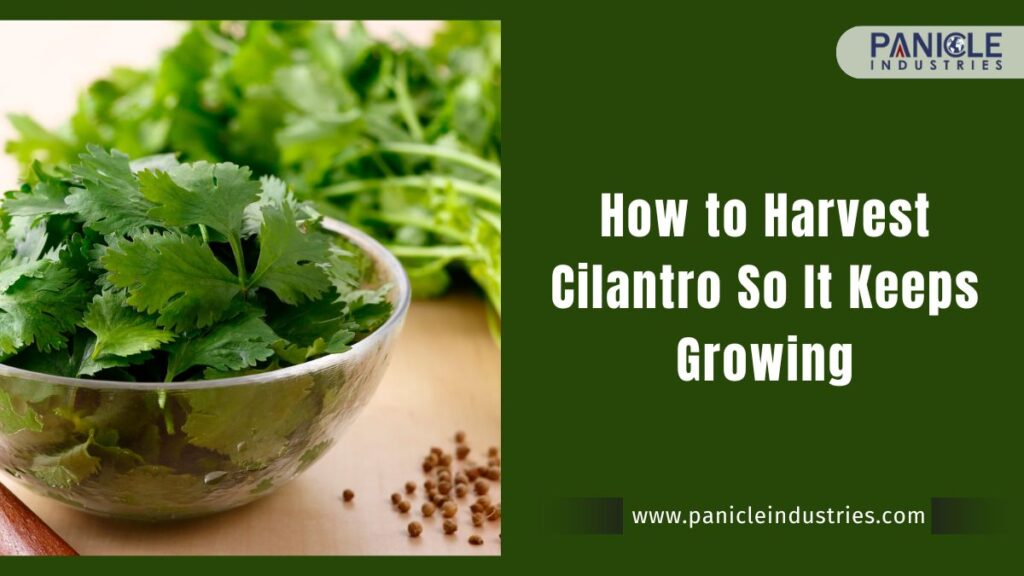If you love growing your own herbs at home, cilantro is one of the easiest and most useful herbs to have. But many people wonder how to harvest cilantro so it keeps growing without dying out or turning bitter. Harvesting cilantro the right way helps the plant stay healthy, fresh, and full of flavor. If you simply cut it all off, the plant may stop producing new leaves. This blog will help you understand the correct steps to harvest cilantro and how to take care of it after harvesting.
Whether you’re growing it in pots, your backyard, or a kitchen garden, these easy tips will ensure you enjoy cilantro all season long. Let’s dive into the details of harvesting cilantro correctly.
What Is Cilantro?
Cilantro is a leafy herb that is commonly used in Indian, Mexican, Middle Eastern, and Asian cooking. It has a fresh, lemony flavor and is often used as a garnish or added to chutneys, soups, and salads. The plant also produces seeds known as coriander, which are also widely used as a spice. But for this blog, we’ll focus on the leafy part of the plant—what we usually call cilantro.
Why Proper Harvesting Matters
Cilantro has a short growing cycle. If not harvested properly, the plant will start flowering and producing seeds (called bolting), which makes the leaves turn bitter. Proper harvesting helps in:
- Extending the plant’s life
- Getting more fresh leaves over time
- Avoiding waste and overgrowth
- Maintaining the taste and flavor
Also read: How to Harvest Basil So It Keeps Growing
When to Start Harvesting Cilantro
Cilantro grows fast. You can begin harvesting it about 3 to 4 weeks after planting when the plant is 6 to 8 inches tall. Look for leaves that are full, green, and tender. Avoid harvesting the very young leaves or the ones that are yellowing.
Pro Tip: Morning is the best time to harvest herbs like cilantro because the leaves are fresh, hydrated, and full of essential oils.
How to Harvest Cilantro So It Keeps Growing
Here’s the step-by-step method for harvesting cilantro without hurting the plant:
1. Use Clean Scissors or Fingers
Always use clean garden scissors or pinch with your fingers to avoid damaging the plant or spreading disease.
2. Harvest the Outer Leaves First
Start by cutting the outer, older leaves, and leave the small, inner leaves untouched. This lets the center of the plant continue to grow.
3. Cut Above the Growing Point
Make your cut about 1 to 2 inches above the soil and never cut the stem from the base unless you are doing a full harvest.
4. Don’t Harvest More Than One-Third
Avoid taking more than one-third of the plant at one time. Taking too much at once can stress the plant and slow down its growth.
5. Harvest Weekly or Every Few Days
Harvest regularly—once a week or even every 3–4 days in warmer climates. This encourages the plant to grow more leaves instead of producing flowers.
How to Keep Cilantro From Bolting
Bolting is when the cilantro plant grows a long stem and starts to flower. Once this happens, the leaves become fewer and the taste changes. To avoid this:
- Keep the plant cool: Cilantro loves cool weather. Too much heat can make it bolt.
- Plant in partial shade: If you’re growing cilantro in a hot region, make sure it gets some shade during the day.
- Keep the soil moist: Water it regularly, but avoid overwatering.
- Harvest often: Frequent cutting keeps the plant focused on growing leaves.
Caring for Cilantro After Harvesting
After harvesting, continue taking care of the plant to encourage regrowth.
1. Water the Plant Gently
Keep the soil evenly moist. Do not let it dry out completely.
2. Use a Balanced Fertilizer
Add a gentle organic fertilizer once every 2–3 weeks. Avoid overfeeding, as cilantro grows best in light soil.
3. Remove Yellow or Dead Leaves
If you see yellow leaves or wilting stems, remove them immediately to help the plant focus energy on healthy growth.
4. Keep Checking for Pests
Aphids and whiteflies are common in herb gardens. Use natural sprays like neem oil if pests appear.
Growing Tips to Extend Your Cilantro Harvest
To enjoy fresh cilantro for months, here are some helpful growing tips:
1. Succession Planting
Instead of planting all at once, plant seeds every 2–3 weeks. This gives you a continuous supply of fresh leaves.
2. Use Containers for Better Control
Growing in pots allows you to move the plant indoors or to a shady spot if the temperature rises.
3. Trim Flowers If They Appear
The moment you notice flower buds (small white or pink flowers), trim them. This delays the bolting process and keeps the leaves tasty.
How to Store Freshly Harvested Cilantro
Once harvested, proper storage helps in keeping the leaves fresh longer.
Refrigerator Method
- Wash the leaves and pat dry.
- Wrap them in a dry paper towel.
- Store them in an airtight container or zip-lock bag in the fridge.
Jar Method (Best for Freshness)
- Place the stems in a glass jar with water like a bouquet.
- Cover loosely with a plastic bag.
- Store in the fridge and change water every 2 days.
Freezing Option
If you harvest more than you need, you can freeze chopped cilantro in an ice cube tray with water or olive oil.
Mistakes to Avoid While Harvesting Cilantro
- Cutting from the top repeatedly – This can damage the growing point.
- Not harvesting often enough – Leads to bolting.
- Overharvesting – Weakens the plant.
- Harvesting too early – The plant may not recover well.
Conclusion
Learning how to harvest cilantro so it keeps growing is simple and highly rewarding. With the right technique, you can enjoy fresh and flavorful cilantro leaves throughout the season. Remember to cut only the mature outer leaves, avoid overharvesting, and take care of the plant regularly. By following proper harvesting practices, you not only keep your cilantro plant alive but also improve its taste and growth. Whether you’re growing it in a garden bed or a pot, this green herb will thrive with a little attention and care. So go ahead, use these tips, and enjoy the benefits of fresh cilantro right from your own home garden!


